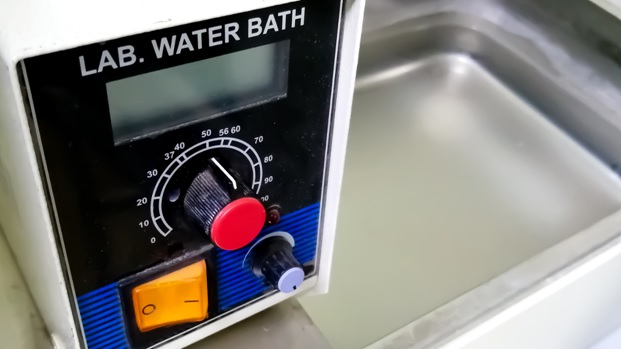
Circulating Water Baths: The Key to Reliable Results in Lab Experiments
8th May 2024

Do you ever find yourself contemplating the lesser-known heroes of your everyday grind while working in the lab?
That's how I feel about the impact of circulating water baths in modern labs. They might not be the flashiest tools in the lab, but boy, do they make a difference!
Since we started HiTechTrader back in '82, I’ve seen firsthand how these nifty devices have become must-haves for anyone serious about their science game.
The Lab Sidekick You Didn’t Know You Needed
Imagine you're cooking a delicate sauce that needs just the right temperature to come out perfect.
That's what a circulating water bath does in the lab. It keeps things at the exact temperature you need, which is super important for a bunch of reasons. Let's break it down:
- Bio and Chem Reactions: Think of enzymes as picky eaters; they only work well under certain conditions. A circulating water bath is like a skilled chef, making sure everything's just right for the reaction to happen.
- Sample Prep and Incubation: Ever tried hatching chicken eggs? They need steady warmth, right? It's the same with many lab samples. They need a cozy, controlled environment to develop properly.
- Keeping Equipment Cool (Or Warm): Just like how you wouldn’t want your computer to overheat, some lab equipment needs a stable temp to work best.
- Other Amazing Applications: From melting things (without turning them into a burnt mess) to testing how materials handle heat, these baths are pretty versatile.
Circulating vs. Non-Circulating: What’s the Big Deal?
Choosing between circulating and non-circulating water baths is kind of like picking between a microwave and an oven. Both heat your food, but in different ways.
Choosing between circulating and non-circulating lab water baths really does boil down to what you're looking for in terms of temperature precision and consistency. Let me break this down a bit more.
The Heart of the Matter
- Circulating Water Baths: These are the go-to for when you need really consistent temperatures. They have a built-in mechanism, like a little pump, that keeps the water moving around. This movement is key because it distributes heat evenly throughout the bath.
- Non-Circulating Water Baths: Now, these are simpler in design. There's no mechanism to move the water around. It's more like a still pond. The heat source warms the water, but without circulation, you can end up with different temperatures in different parts of the bath.
When to Choose Which
- Precision Work: If your experiments need precise temperature control – think complex chemical reactions or sensitive biological samples – then circulating lab water baths are your best bet. They’re like that dependable friend who always delivers what you expect, no surprises.
- Routine Tasks: For everyday tasks where a few degrees here or there won’t make a big difference, non-circulating baths can be a cost-effective and straightforward choice. They're like the trusty microwave that heats your coffee just fine, even if it might be a bit hotter at the top.

Best Practices with Circulating Water Baths
Using a circulating water bath is pretty straightforward, but there are some tips and tricks to keep it humming:
1. Water Level and Quality
Do: Regularly check the water level. Running a bath too low can damage the heating elements – kind of like running a car without enough coolant.
Tip: Use distilled water if possible. This helps prevent mineral buildup, which can affect heating efficiency and bath longevity.
2. Keeping It Pristine
Don’t: Neglect cleaning. Over time, water baths can become a breeding ground for all sorts of microbial life.
Tip: Clean it regularly with mild, non-abrasive cleaners. Also, consider using additives that prevent algae and bacterial growth. Think of it like cleaning a fish tank – you want a clean environment for your 'fish' (in this case, your experiments).
3. Temperature Accuracy
Do: Regularly check and calibrate the temperature settings. Even the best equipment can drift over time.
Tip: Use a reliable external thermometer to verify the bath's temperature. It's like using an oven thermometer to ensure your baking temperature is spot on.
4. Placement in the Lab
Don't: Just put your water bath anywhere. The placement in the lab can affect its performance and safety.
Tip: Place it on a stable, level surface away from high traffic areas to prevent accidental bumps. Also, keep it away from direct sunlight and other heat sources to prevent external temperature fluctuations.
5. Regular Maintenance
Tip: Beyond daily or weekly routines, set a schedule for thorough maintenance checks. This might involve inspecting electrical cords for wear and tear, checking for any signs of leakage, and ensuring all components are functioning correctly.
Why Your Lab Will Love You for It
In today’s labs, choosing the right circulating water bath is like having a reliable lab assistant. It’s there, quietly making sure your experiments go smoothly and your results are consistent.
It’s about getting things right and keeping them right.
So, What’s Next?
If you’re ready to take your experiments to the next level, then it’s time to visit HiTechTrader.com today.
Remember, in science, sometimes it’s the simplest things that can make the biggest difference. Keep exploring, stay curious, and here’s to making your next big discovery!
